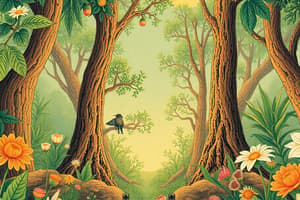Podcast
Questions and Answers
What are the eight major terrestrial biomes recognized globally?
What are the eight major terrestrial biomes recognized globally?
- Tropical rainforests, savannas, deserts, grasslands, temperate coniferous forests, temperate deciduous forests, tundras, and freshwater wetland (correct)
- Tropical rainforests, savannas, mangroves, grasslands, temperate coniferous forests, temperate deciduous forests, deserts, and freshwater wetland
- Tropical rainforests, coral reefs, deserts, taigas, temperate coniferous forests, temperate deciduous forests, tundras, and oceans
- Tropical rainforests, savannas, deserts, grasslands, temperate coniferous forests, savannas, tundras, and mangroves
Why are transition zones between biomes important?
Why are transition zones between biomes important?
- They lead to the loss of biodiversity
- They allow certain species to thrive across broad areas (correct)
- They prevent species from adapting to new environments
- They have no ecological significance
What is one of the vital roles that ecosystems play in our daily lives?
What is one of the vital roles that ecosystems play in our daily lives?
- Decreasing recreational opportunities
- Reducing food availability
- Increasing pollution levels
- Providing clean air and water (correct)
What could happen by 2100 if current trends continue?
What could happen by 2100 if current trends continue?
Why is it important to conserve and protect ecosystems?
Why is it important to conserve and protect ecosystems?
What does biodiversity refer to?
What does biodiversity refer to?
Why is biodiversity important for ecosystems?
Why is biodiversity important for ecosystems?
What defines a biome?
What defines a biome?
Which factor contributes to biodiversity according to scientists?
Which factor contributes to biodiversity according to scientists?
How does maintaining global biodiversity affect ecosystem function?
How does maintaining global biodiversity affect ecosystem function?
Flashcards are hidden until you start studying
Study Notes
Ecosystems
An ecosystem is a complex network of living organisms and their physical environment interacting with each other over time. It's a community made up of various species all working together in harmony. This interconnected system includes plants, animals, microbes, water, soil, air, and sunlight, among many others, all playing unique roles within it. These systems can range from small pond habitats hosting only two different types of plants and animals to vast expanses like oceans teeming with life forms unique to this environment.
Biodiversity
Biodiversity refers to the variety and abundance of living things in a particular habitat or geographical area. It's critical because it increases a community's resilience against disturbances and ensures that if one species were to disappear due to some natural catastrophe, there would still likely be another species capable of filling its niche. Therefore, maintaining and increasing global biodiversity is crucial for healthy ecosystem function. Scientists have identified several key factors that contribute to biodiversity, including habitat complexity, human population density, the number of native plant and animal species, and the amount of land set aside for conservation purposes.
Biomes
A biome is defined by specific climate conditions such as temperature, precipitation, wind patterns, etc., which determine what type(s) of plants and animals live there. There are eight major terrestrial biomes recognized globally: tropical rainforests, savannas, deserts, grasslands, temperate coniferous forests, temperate deciduous forests, tundras, and freshwater wetland. While these regions may seem distinct and separate, they actually blend into each other, forming transition zones that allow certain species to thrive across broad areas. Each biome has its own unique collection of flora and fauna adapted specifically to cope with the environmental challenges presented by those climatic conditions.
Importance of maintaining ecosystem health
Ecosystems play vital roles in our daily lives - providing clean air and water, food and fiber for humans, pollination services, flood control through wetlands, nutrient cycling, waste treatment, and recreational opportunities. Protecting them isn't just about saving nature; it's also about preserving valuable resources upon which we depend. However, recent studies suggest that the world could lose half of its wilderness by 2100 if current trends continue. To ensure the continued prosperity of both people and planet, now more than ever before, we must prioritize conserving and protecting our precious ecosystems and their diverse inhabitants.
Studying That Suits You
Use AI to generate personalized quizzes and flashcards to suit your learning preferences.




